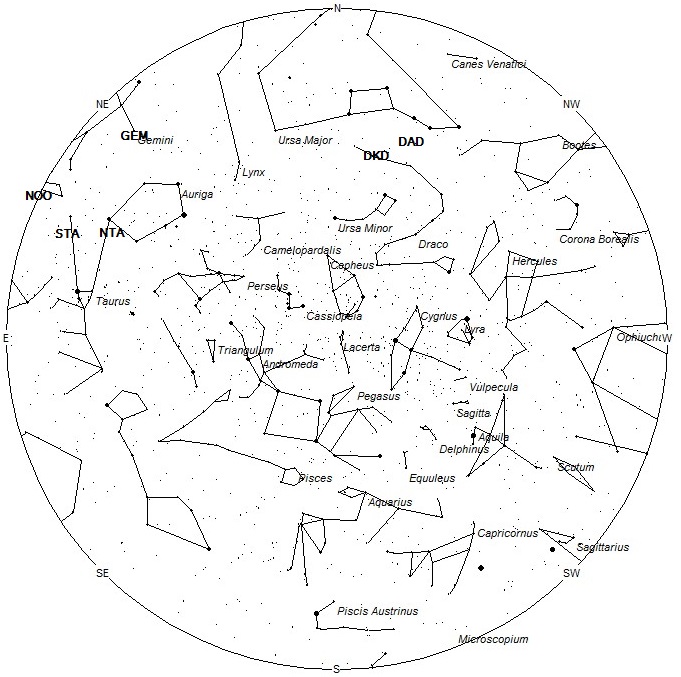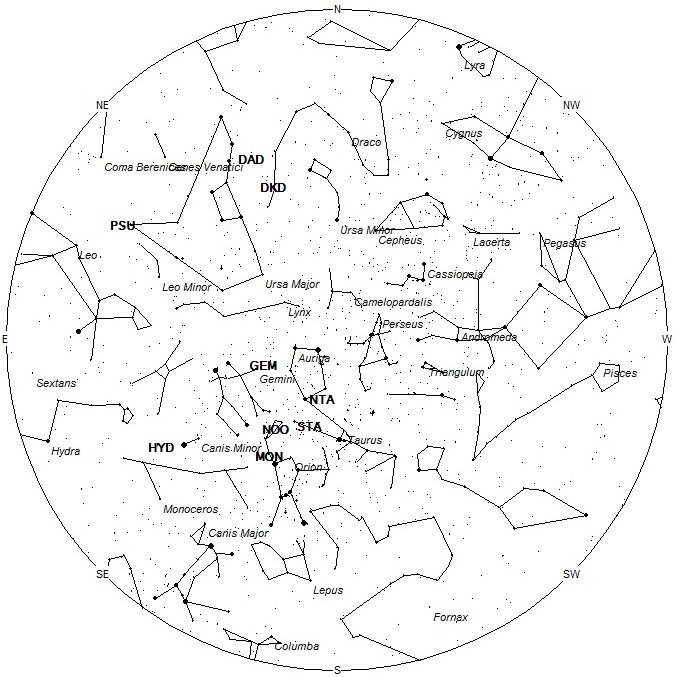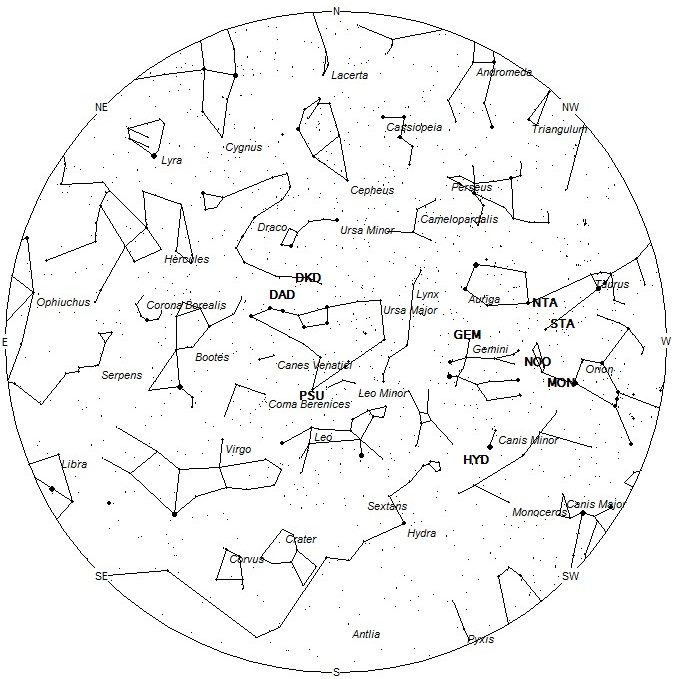No matter where you live, the first half of December provides some of the best meteor activity of the year. Unfortunately this year the bright moon will hamper the viewing of this activity during the second week of the month. In the northern hemisphere the sporadic rates are still strong plus you can also count on strong activity from the Geminids, which peak on December 14th. There are also several minor radiants that add a few meteors each hour. All of these centers of activity are located high in the sky during the early morning hours this time of year. Much of the activity mentioned above can also be seen from the southern hemisphere. While the sporadic rates are not as strong as those seen from the north, they are stronger than the previous months and heading for a maximum in February. The warm, but short summer nights south of the equator make for some great viewing as long as the moon does not interfere.
During this period the moon reaches its first quarter phase on Wednesday December 4th. At this time the moon will be located 90 degrees east of the sun and will set near 02:00 Local Summer Time (LST). This weekend the waxing crescent moon will set near midnight allowing the more active morning hours to be free of interfering moonlight. The estimated total hourly meteor rates for evening observers this week is near 3 for those viewing from the southern hemisphere and 4 for those located north of the equator. For morning observers the estimated total hourly rates should be near 12 as seen from tropical southern locations (25S) and 17 as seen from mid-northern latitudes (45N). The actual rates will also depend on factors such as personal light and motion perception, local weather conditions, alertness and experience in watching meteor activity. Evening rates are reduced due to moonlight. Note that the hourly rates listed below are estimates as viewed from dark sky sites away from urban light sources. Observers viewing from urban areas will see less activity as only the brightest meteors will be visible from such locations.
The radiant (the area of the sky where meteors appear to shoot from) positions and rates listed below are exact for Saturday night/Sunday morning November 30/December 01. These positions do not change greatly day to day so the listed coordinates may be used during this entire period. Most star atlases (available at science stores and planetariums) will provide maps with grid lines of the celestial coordinates so that you may find out exactly where these positions are located in the sky. A planisphere or computer planetarium program is also useful in showing the sky at any time of night on any date of the year. Activity from each radiant is best seen when it is positioned highest in the sky, either due north or south along the meridian, depending on your latitude. It must be remembered that meteor activity is rarely seen at the radiant position. Rather they shoot outwards from the radiant so it is best to center your field of view so that the radiant lies at the edge and not the center. Viewing there will allow you to easily trace the path of each meteor back to the radiant (if it is a shower member) or in another direction if it is a sporadic. Meteor activity is not seen from radiants that are located below the horizon. The positions below are listed in a west to east manner in order of right ascension (celestial longitude). The positions listed first are located further west therefore are accessible earlier in the night while those listed further down the list rise later in the night.
These sources of meteoric activity are expected to be active this week.
.
The December Phoenicids (PHO) are a periodic shower that rarely produces noticeable activity. The only impressive display produced so far by this shower occurred in 1956 when ZHR’s were near 100. The normal rage for these meteors is from December 4-6 with a peak on December 5th. The radiant at maximum is located at 01:02 (016) -45. This position lies in central Phoenix, just north of the 3rd magnitude star known as beta Phoenicis. For those viewing from the northern tropics southward, this position also lies 10 degrees northwest of the bright 1st magnitude star known as Achernar (alpha Eridani). This year though Phoenicid activity has already been detected from November 12-14 and also expected on November 23rd and December 2nd. The radiant for the possible encounter on December 2nd is different than the normal radiant listed above. On December 2nd look for this activity at 00:26 (007) -28 which lies in northern Sculptor, 10 degrees southwest of the 2nd magnitude star known as Diphda (beta Ceti) This area of the sky is best placed as soon as evening twilight ends. These meteors are best seen from the southern hemisphere where the radiant lies much higher in the sky. For those viewing from the northern hemisphere, only those in the northern tropics have any real chance of seeing activity from this source. At only 12 km/sec. the Phoenicids produce extremely slow meteors.
The Northern Taurids (NTA) are active from a large radiant located at 05:15 (079) +28. This area of the sky is located on the Taurus/Auriga border, 2 degrees west of the 2nd magnitude star known as El Nath (beta Tauri). This position is close to the Southern Taurids so care must be taken in separating these meteors. You should have the two radiants near the center of your field of view to properly differentiate these sources. Current rates should be 1 per hour as seen from mid-northern latitudes and less than 1 per hour as seen from south tropical latitudes (25S). These meteors may be seen all night long but the radiant is best placed near 0200 LST when it lies on the meridian and is located highest in the sky. With an entry velocity of 28 km/sec., the average Northern Taurid meteor would be of slow velocity.
The Southern Taurids (STA) are active from a large radiant centered near 05:22 (081) +21. This position lies in eastern Taurus, 7 degrees south of the 2nd magnitude star known as El Nath (beta Tauri). These meteors may be seen all night long but the radiant is best placed near 0200 LST when it lies on the meridian and is located highest in the sky. Hourly rates at this time should be less than 1 no matter your location. With an entry velocity of 27 km/sec., the average Southern Taurid meteor would be of slow velocity.
The Monocerotids (MON) are active from November 28th through December 27th with the peak activity occurring on December 13th. The radiant is currently located at 06:06 (091) +09. This position lies in northeastern Orion, 2 degrees northeast of the 1st magnitude orange star known as Betelgeuse (Alpha Orionis). This position is only 7 degrees south of the radiant of the November Orionids so care must be taken to distinguish between the two. Current rates should be less than 1 per hour no matter your location. Rates at maximum may reach 2 per hour. The Monocerotids are best seen near 0100 LST when the radiant lies highest above the horizon. At 41 km/sec. the Monocerotids produce mostly meteors of medium velocity.
The November Orionids (NOO) are currently the strongest radiant in the sky but will soon be surpassed by the Geminids. They are active from a radiant located at 06:14 (093) +16. This area of the sky lies in northeastern Orion, 5 degrees west of the 2nd magnitude star known as Alhena (gamma Geminorum). This radiant is best placed in the sky near 0300 LST, when it lies highest above the horizon. This stream is active from November 7 through December 17, with maximum activity occurring on November 29. Rates should be near 3 per hour as seen from the northern hemisphere and 2 as seen from south of the equator. With an entry velocity of 43 km/sec., most activity from this radiant would be of medium speed.
The Geminids (GEM) are active from December 1-22, with peak activity occurring on December 14th. This weekend the radiant is located near 06:43 (101) +35. This position lies in northern Gemini, 1 degree northwest of the 4th magnitude star known as theta Geminorum. Rates this weekend should be less than 1 no matter your location. Hourly rates should increase to near 5 by the end of this period, surpassing the November Orionids as the strongest source of meteors in the sky. At 34 km/sec. the Geminids produce mostly meteors of medium velocity.
The Puppid-Velids (PUP) are a vast complex of weak radiants located in the constellations of Puppis and Vela. Visual plots and photographic studies have revealed many radiants in this area during November and December. The combined strength of these radiants can produce a ZHR of 10. Actual hourly rates will be much less unless you happen to be observing from the deep Southern Hemisphere. Activity from this source begins around December 1st. The center of this activity is currently located at 07:58 (119) -45. This position lies on the Puppis/Vela border, 3 degrees northwest of the 2nd magnitude star known as gamma Velorum. Peak rates occur near December 7. These meteors are best seen near 0300 LST when the radiant lies highest above the horizon in a dark sky. Observers located in the Southern Hemisphere have an advantage viewing this shower as the radiant will rise higher into their sky allowing more activity to be seen. Since the radiant lies low in the south for most northern hemisphere observers, meteors seen from north of the equator tend to be long in length and long-lasting. At 40 km/sec. the Puppid-Velids produce meteors of average velocity.
The sigma Hydrids (HYD) are active from a radiant located at 08:00 (120) +04. This area of the sky is located in Canis Minor, 4 degrees southeast of the brilliant zero magnitude star known as Procyon (alpha Canis Minoris). Current rates should be near 1 per hour no matter your location. These meteors are best seen near 0300 LST, when it lies highest above the horizon in a dark sky. With an entry velocity of 61 km/sec., the average sigma Hydrid meteor would be of swift velocity
The Psi Ursa Majorids (PSU) were discovered by observers in Japan using data from SonotaCo. This shower is active from December 2-10 with maximum activity occurring on December 5th. At maximum the radiant is located at 11:16 (169) +42. This position lies in central Ursa Major, 3 degrees southeast of the third magnitude star known as Psi Ursae Majoris. This area of the sky is best placed during the last hour before dawn, when it lies highest above the horizon in a dark sky. Current rates would most likely be less than one per hour and may reach 1 per hour at maximum. Observers south of the equator would see rates less than 1 per hour due to the lower radiant elevation. At 62km/sec., the average Psi Ursa Majorid meteor would be swift.
The December Kappa Draconids (DKD) are another shower discovered in Japan by observers using data from SonotaCo. This short-lived shower is only active from December 2-7 with maximum activity occurring on December 4th. On the night of maximum the radiant will be located at 12:29 (187) +70. This position lies in extreme western Draco, close to the faint star Kappa Draconis. While the radiant lies above the horizon all night for most of the northern hemisphere, it is best placed during the last hour before dawn, when it lies highest above the horizon in a dark sky. Rates could reach 2 per hour on the morning of the 3rd. Away from that morning I would expect hourly rates of less than 1. Due to the high northerly declination of the radiant these meteors are not visible from most of the southern hemisphere. At 41km/sec., the average December Kappa Draconid meteor would be of medium velocity.
The December Sigma Virginids (DSV) was discovered by John Greaves using the data of SonotaCo. IMO video cameras confirmed that this source is active during the month of December. Peak rates occur near December 14th. The current radiant location is at 12:36 (189) +11 which places it in northern Virgo, 1 degree west of the faint star known as rho Virginis. Current hourly rates would be less than 1 shower members no matter your location. These meteors are best seen during the last dark hour before dawn, when the radiant lies highest above the horizon in a dark sky. At 68 km/sec. the December Sigma Virginids would produce mostly swift meteors.
The December Alpha Draconids (DAD) were discovered by the Japanese observers using data from SonotaCo. This source is active from November 30-December 15, with maximum activity occurring on December 8th. The radiant is currently located at 13:18 (199) +60. This position actually lies in northeastern Ursa Major, 5 degrees north of the second magnitude star known as Mizar (zeta Ursae Majoris). These meteors are best seen during the last dark hour before dawn, when the radiant lies highest above the horizon in a dark sky. This shower is not well seen from the southern hemisphere. Current rates would most likely be near 1 per hour as seen from the northern hemisphere. Observers south of the equator would see rates less than 1 per hour due to the lower radiant elevation. At 44 km/sec. meteors from this source would produce mostly medium velocity meteors.
As seen from the mid-northern hemisphere (45N) one would expect to see approximately 12 sporadic meteors per hour during the last hour before dawn as seen from rural observing sites. Evening rates would be near 3 per hour. As seen from the tropical southern latitudes (25S), morning rates would be near 8 per hour as seen from rural observing sites and 2 per hour during the evening hours. Locations between these two extremes would see activity between the listed figures. Evening rates are reduced by moonlight during this period.
The list below offers the information from above in tabular form. Rates and positions are exact for Saturday night/Sunday morning except where noted in the shower descriptions.
| SHOWER | DATE OF MAXIMUM ACTIVITY | CELESTIAL POSITION | ENTRY VELOCITY | CULMINATION | HOURLY RATE | CLASS |
| RA (RA in Deg.) DEC | Km/Sec | Local Standard Time | North-South | |||
| December Phoenicids (PHO) | Dec 05 | 01:02 (016) -45 | 16 | 20:00 | <1 – <1 | III |
| Northern Taurids (NTA) | Nov 03 | 05:15 (079) +28 | 28 | 00:00 | 1 – <1 | II |
| Southern Taurids (STA) | Oct 29 | 05:22 (081) +21 | 27 | 00:00 | <1 – <1 | II |
| Monocerotids (MON) | Dec 13 | 06:06 (091) +09 | 41 | 01:00 | <1 – <1 | II |
| November Orionids (NOO) | Nov 29 | 06:14 (093) +16 | 43 | 01:00 | 3 – 2 | II |
| Geminids (GEM) | Dec 14 | 06:43 (101) +35 | 34 | 02:00 | <1 – <1 | I |
| Puppid-Velids (PUP) | Dec 07 | 07:58 (119) -45 | 40 | 03:00 | <1 – 1 | II |
| sigma Hydrids (HYD) | Dec 06 | 08:00 (120) +04 | 61 | 03:00 | 2- 2 | II |
| Psi Ursa Majorids (PSU) | Dec 05 | 11:16 (169) +42 | 62 | 06:00 | <1 – <1 | IV |
| December Kappa Draconids (DKD) | Dec 04 | 12:29 (187) +70 | 41 | 07:00 | 1 – <1 | IV |
| December Sigma Virginids (DSV) | Dec 14 | 12:36 (189) +11 | 68 | 07:00 | <1 – <1 | IV |
| December Alpha Draconids (DAD) | Dec 08 | 13:18 (199) +60 | 44 | 08:00 | <1 – <1 | IV |




